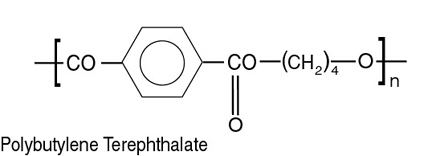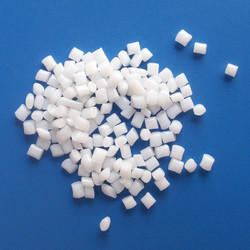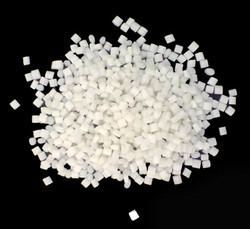Melting point 223 °C | Formula (C12H12O4)n | |
 | ||
IUPAC ID Poly(oxy-1,4-butanediyloxycarbonyl-1,4-phenylenecarbonyl) | ||
Polybutylene terephthalate
Polybutylene terephthalate (PBT) is a thermoplastic engineering polymer that is used as an insulator in the electrical and electronics industries. It is a thermoplastic (semi-)crystalline polymer, and a type of polyester. PBT is resistant to solvents, shrinks very little during forming, is mechanically strong, heat-resistant up to 150 °C (or 200 °C with glass-fibre reinforcement) and can be treated with flame retardants to make it noncombustible.
Contents
- Polybutylene terephthalate
- Global polybutylene terephthalate pbt market 2015 2019
- Applications
- Trade names
- References

PBT is closely related to other thermoplastic polyesters. Compared to PET (polyethylene terephthalate), PBT has slightly lower strength and rigidity, slightly better impact resistance, and a slightly lower glass transition temperature. PBT and PET are sensitive to hot water above 60 °C (140 °F). PBT and PET need UV protection if used outdoors, and most grades of these polyesters are flammable, although additives can be used to improve both UV and flammability properties.

Global polybutylene terephthalate pbt market 2015 2019
Applications

Polybutylene terephthalate is used for housings in electrical engineering, but also in automotive construction as plug connectors and in households for example in showerheads or irons. It is also found processed into fibers in toothbrushes and is used in the keycaps of some high end computer keyboards because the texture is highly resistant to wear and discoloration due to UV radiation.

PBT can also be made into yarn. This has a natural stretch similar to Lycra and can be incorporated into sports wear. Due to its chlorine resistance it is commonly found in swimwear. Further, recent studies have shown that PBT has superior UV properties to PET based fabrics such as T400.

PBT, especially glass fibre grades can be effectively fire retarded with halogen free products. Phosphorus-based flame retardant systems are used in these Fire-safe polymers and are based on aluminium diethyl phosphinate and synergists. They are designed to meet UL 94 flammability tests as well as Glow Wire Ignition Tests (GWIT), Glow Wire Flammability Test (GWFI) and Comparative Tracking Index (CTI). Main applications are in the electrical and electronics (E&E) industry.
Trade names


